
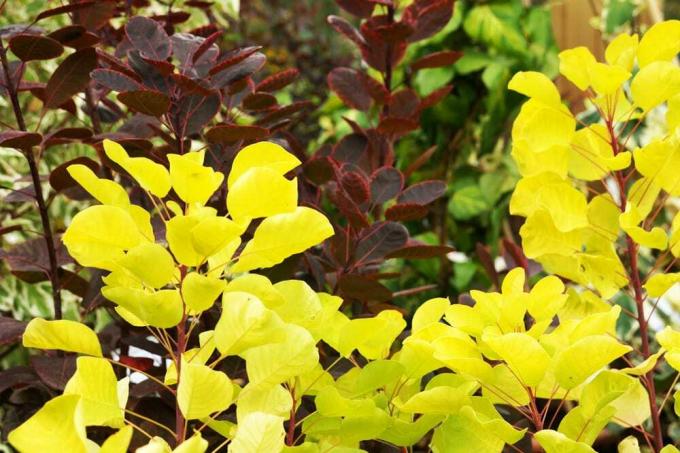
Table of contents
- The best time to cut back - when exactly to cut?
- Reasons for the cut
- Proceed step by step when cutting back
- Are there different pruning needs depending on the subspecies?
- Useful garden tools for pruning these shrubs
- The different types of pruning
- The shape cut
- Force a specific shrub shape with a rejuvenation or care cut
- The Radical Cut
- Tip
- The cut of the inflorescences and infructescences
- This is how the cuts are correctly applied when pruning
- A difficult case when propagating cuttings
- Care needs right after the cut
- The flower after pruning
- What to do with the clippings?
Regular pruning is not absolutely necessary for the willow tree, but pruning measures can make sense for various reasons.
The best time to cut back - when exactly to cut?
Wig shrubs are generally not particularly sensitive to various types of pruning. Therefore, in principle, it does not cause any major damage all year round if individual branches that are perceived as disturbing are cut out or dead wood removed. Nevertheless, there are also certain points in time that should be used for more extensive editing measures. Since the wounds of a smoke bush can "bleed" relatively heavily when pruned in late spring or summer, If possible, no radical pruning with many large-area wounds should be carried out during this period become. Therefore, the following tips apply to the pruning:
- smaller cuts can be made all year round
- If a smoke bush is radically shortened, the period of sap dormancy between late autumn and early spring should be used
- in spring: cut as far as possible before new shoots appear
- Cut back after flowering: unusual due to the decorative infructescence and foliage colour
- later pruning before the first snow is easily possible
Reasons for the cut
If there is enough space on your property, you can let the wig tree grow as an easy-care garden plant without annual pruning. However, there can definitely be situations in which a pruning makes sense:
- when there is not enough space in the garden
- from neighborly or legal reasons (height of hedges, shadows cast etc.)
- to rejuvenate older specimens
- for using the fruit stands as a decorative object
- to prevent the seed heads from spreading in the garden
- to sometimes save ailing plants with a care cut
- in order to achieve a certain growth form through topiary
Wig bushes are in principle very well suited for training in certain forms, which then only require very little pruning over the years. The various subspecies of the willow tree are similarly uncomplicated when it comes to maintaining compact growth forms for green roofs or when used as a hedge plant. If, on the other hand, you want to cut back to rejuvenate an old specimen or to fight a disease, the pruning can be radically comprehensive. In comparison, the interventions for obtaining the infructescence act as a decorative object or for the preventive removal of these for practical reasons more like cosmetic measures im passing.
Proceed step by step when cutting back
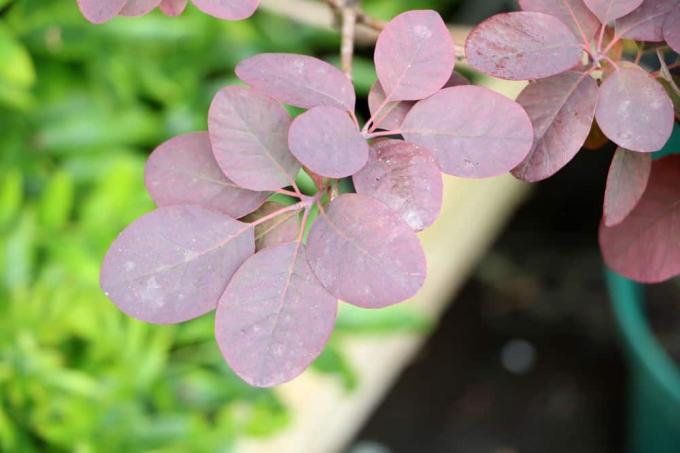
The most important thing when pruning plants is a well thought-out approach. Ideally, therefore, proceed according to the following list:
- Choosing the right time to cut: when exactly to cut?
- Planning the best cut variant: radical or cautious?
- Preparation of necessary tools
- Pruning the plant in a multi-step process until the desired shape is achieved
- Supply of larger interfaces with means for tree wound care
- pay special attention to plant care in the first few weeks after cutting
- Increased watering interval when pruning in spring or summer: when is more water needed?
- Disposal of the cuttings (outside the garden in the event of fungal diseases or Mildew)
Are there different pruning needs depending on the subspecies?
In principle, for example, a red wig tree has similar care and location requirements as the common wig tree and the yellow-leaved wig tree. Of course, how much growth a particular subspecies achieves annually at its location can affect the need for pruning.
For example, was the widespread smoke bush planted correctly and in the first Years of life also properly cared for, annual growth rates of about 40 centimeters are quite possible expect. Therefore, as a tip: Regardless of the color of the leaves, pruning measures should always be preferred between Autumn and spring take place when there is the least possible loss of plant sap at the interfaces comes.
Useful garden tools for pruning these shrubs
For a pruning with a caring character and as little health stress as possible for the respective plant, suitable garden tools that are as well maintained as possible should be used. The following tools may come in handy when pruning the willow bushes:
- Gloves
- pruning shears
- saw
- plant shears
- hedge trimmer
While gloves may not be a tool in themselves, they can be used for relatively sensitive and People plagued by allergies have effective protection against the ingredients of the wig bushes represent. They also protect against discoloration from the leaf material and wood, which was and is used as a coloring agent in some varieties. Depending on the thickness of the twigs and branches to be cut, plant shears, pruning shears or saws are used. The sharper and cleaner these tools are, the less pruning will affect the health of your plants. If you have already trained your willow tree to a certain shape and only the annual one If you want to shorten offspring, a hedge trimmer can usually do a good and, above all, quick service afford.
Note: When trimming with hedge trimmers in a time-saving manner, many leaves are usually also cut and divided. With these "cutting inaccuracies" that can hardly be avoided, you should use plant shears by hand as soon as possible be touched up, otherwise the damaged leaves will impair the appearance of the plant when they are wilted can.
The different types of pruning
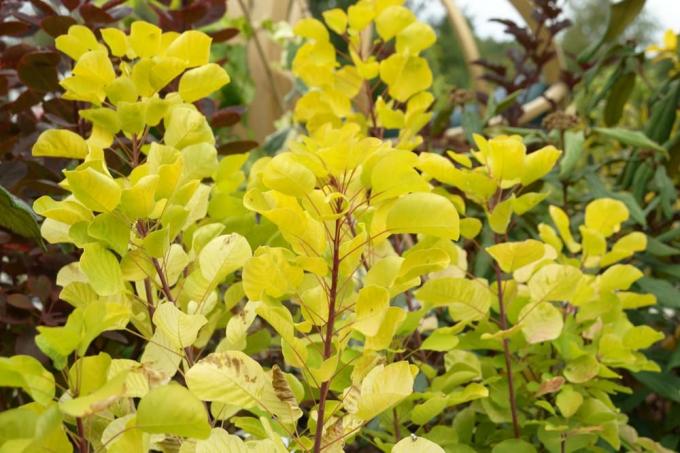
A distinction is made between pruning plants in general and caring for wig bushes different types of cutting measures, depending on their respective objectives and procedures be delimited:
- topiary
- Rejuvenation or maintenance pruning
- radical cut
- pruning of inflorescences infructescence
The shape cut
When topiary, you should note that very young specimens of the wig tree should not be cut at all. Otherwise the plants, which are somewhat more sensitive when they are young, have no chance of developing a healthy and strong plant base and it may be possible. there may even be problems with the frost tolerance of the plants, which are otherwise relatively uncomplicated in this respect. Basically, there are hardly any limits to your imagination when it comes to shaping and you can do it Wig bush over the years through targeted cuts to a rough hedge or educate spherical shape.
It looks even more impressive if you cut off the fresh offspring of each year just above the thickened main branches. Over time, this results in trunk forms that are rounded at the top, as can often be seen in the regularly tended plane trees in urban gardens and parks. In general, a maximum of one third of the plant mass should be cut off when topiary is carried out regularly.
Force a specific shrub shape with a rejuvenation or care cut
The decision as to when to prune a smoke bush is often related to a certain height growth and the corresponding conditions in the garden. In this sense, the already mentioned topiary of the willow tree usually aims for a more compact shape, which is why expansive and outward-facing branches are boldly removed. However, it can also make sense for the preservation of an aging specimen to thin out the "treetop" of the overgrown smoke tree with a rejuvenation and care cut.
This applies, for example, to the red smoke tree or to particularly shady and damp locations. Similar to certain fruit tree varieties, the plant material should then be built up so that it is permeable to air care must be taken to avoid increased susceptibility to powdery mildew as a result of poorly drying leaf material to prevent To do this, preferably cut out the particularly crooked twigs and branches from the inside of the shrub structure.
The Radical Cut
Care measures in which at least two-thirds of all twigs and branches and, if necessary, part of the roots are removed are referred to as radical cuts. This incision is often used at a time when either an illness requires it or the necessary incision has been overlooked for many years. Despite the courageous removal of numerous branches, this type of cut should also be used in the future desired shrub shape and always leave some leaf mass (except sometimes in the case of fungal diseases). become. In the case of a radical cut in particular, attention should be paid to the necessity of the measure on the one hand, but also to the right point in time and a well thought-out procedure on the other. In order to keep the additional stress for the affected plant as low as possible, a period between late autumn and spring (before new growth) should be chosen for the radical cut.
Tip
A red smoke bush (Cotinus coggygria 'Royal Purple') is generally more susceptible to potential powdery mildew infestation than smoke smoker. If, to save an infested specimen, a pruning that radically interferes with the growth habit is carried out, the cut material should be disposed of afterwards and not on your own compost heap land. In addition, immediately after the appearance of a powdery mildew infestation in the same location for a period of some years no other plants are planted that are known for their susceptibility to powdery mildew diseases are. If a radical pruning takes place for reasons of disease or control of fungi, then if necessary the affected roots are also shortened to stimulate fresh growth.
The cut of the inflorescences and infructescences
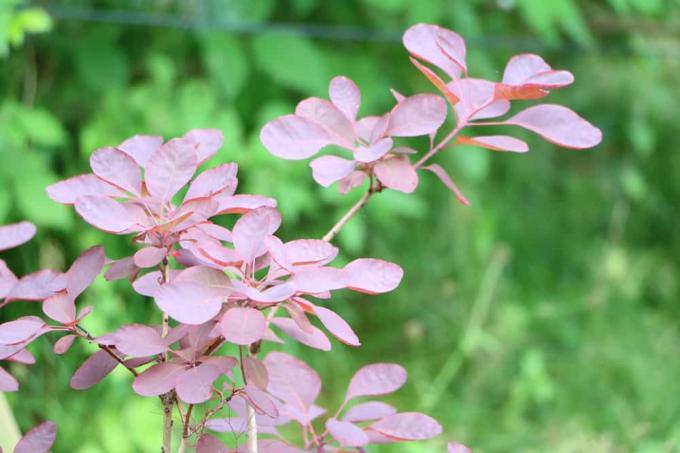
From a plant health point of view, there is really no reason to cut off the flowers of the willow tree once they have faded. While cutting the wilting blooms is recommended when caring for many balcony flowers, to avoid the exertion of the plants To save seed formation, you would take care of one of the most decorative aspects of this plant species with the seed pods of the smoke bush bring. In addition, it is true that this means an "exertion of strength" for each plant, but the fruit formation is not really important in the case of the vigorous smokers. The use of inflorescences the extremely magnificent fruit stands as decorative objects is very uncomplicated in itself: these can be easily cut off in autumn if necessary and placed in the house.
Tip:
Cut off the mature seeds before winter to use them as permanent parts in dried bouquets and arrangements. Be careful not to miss the right time for this in late autumn. Otherwise, in particularly wet weather, the infructescences could have started to mold.
This is how the cuts are correctly applied when pruning
Due to the sparse growth of this shrub with its alternate leaves, the exact Intersections when shortening the individual shoots are set a bit "by feel". become. However, it is advisable for an optical effect to make the cuts on the thinner branches just a little above a branch. With thicker branches or pieces of trunk, you should make sure not to leave an absolutely horizontal cutting surface. Rainwater would constantly accumulate on such a surface, which could make wound healing more difficult and pose a risk to plant health.
A difficult case when propagating cuttings
If you miss the cut from cuttings in this list, please give the following information: Smoke bushes are only suitable for propagation by cuttings to a very limited extent. Sowing the seeds and cultivating so-called sinkers promise more success. To do this, longer side shoots near the ground are covered with some soil and only separated from the mother plant as offshoots after root formation. If possible, save yourself the tedious attempt to obtain young plants of the willow tree from cuttings. Instead of growing cuttings under complex conditions and with special rooting hormones, you can grow young plants from layering much more easily.
Care needs right after the cut
Especially after very pronounced cutting measures, attention should be paid to an adequate water supply and to the wound healing at the cut points. The latter is especially true when a red smoke tree is in a location that is not too sunny grows, since the red variety of the smoke tree is generally more susceptible to powdery mildew and various fungal diseases is. Accordingly, the plants should be sufficiently watered immediately after cutting, but the interfaces should be kept as dry as possible.
The flower after pruning
In general, you must assume that a twig tree that has been pruned back very much will no longer produce flowers in the same year and therefore will not produce any decorative fruit buds. The situation is different when removing individual large branches as part of a rejuvenation cut as well as for topiary: here, as a rule, enough flower buds remain for a decorative blossom receive.
What to do with the clippings?
You can compost the cut twigs and branches of smoke bushes as normal or use systems such as the bio bin or dispose of at the local recycling center. As mentioned above, it is not worth trying to propagate (successful only under difficult conditions) by cuttings. The branches resulting from a radical pruning can certainly reach a considerable thickness and thus possibly can also be processed into firewood or chopped into litter. Cuttings should not be composted in your own garden if they are the remains of plants that have died from powdery mildew or the infamous Verticillium wilt.
 Home editorial office
Home editorial office
Learn more about pruning

Eucalyptus dried up: cut back now?
When a eucalyptus dries up, some owners immediately think of cutting it back. Because they want to see fresh green bud quickly. The chances of that happening may be good. But one thing must not be left out: research into the causes! Otherwise a new cycle of drying up and cutting begins.
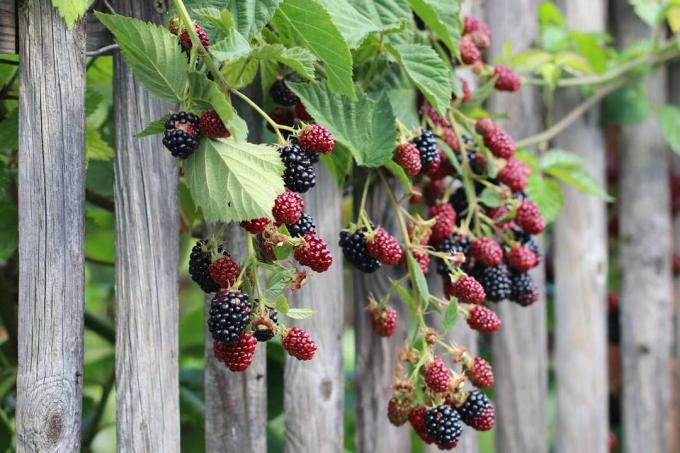
Cut blackberries: Instructions for the right cut
Bramble branches only bear fruit for one summer, after which they are used up and die off in winter. It's a good thing that new canes grow back in time for the following year. Cutting care means: What no longer supports should be removed, young rods must be optimally trained.

cutting snowball | 13 tips for pruning
When it comes to snowballs (Viburnum), the opinions of numerous hobby gardeners differ when it comes to cutting. Main reason against pruning: Destruction of the natural appearance by pruning. Find out now when it is unavoidable and which tips should be heeded.

Cutting sage: 6 tips for cutting back
Cutting measures and their ideal time depend on the species of sage plants, because they have differentiated ways of life. There are woody and herbaceous representatives that require different attention. In order to carry out the measures, a basic set of tools is helpful.

Pruning hydrangeas: when is the right time?
Hydrangeas are a real beauty because of their flowers. In the long term, however, the flowering power is only maintained if regular pruning takes place. Because cutting off withered or dried plant parts offers protection. The following guide shows when this measure should be taken.
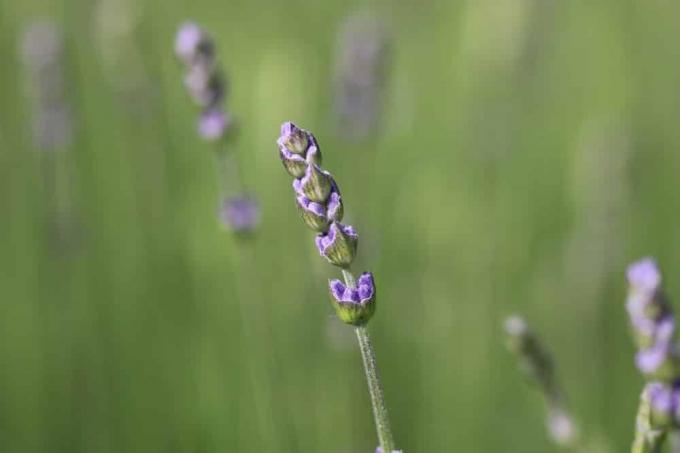
Cutting Lavender | When is the best time?
Lavender is a popular perennial, but difficult to cut. Without regular pruning, the shrub becomes lignified and less robust. Choosing the right time is important for pruning. When to cut depends on the use of the perennials.
